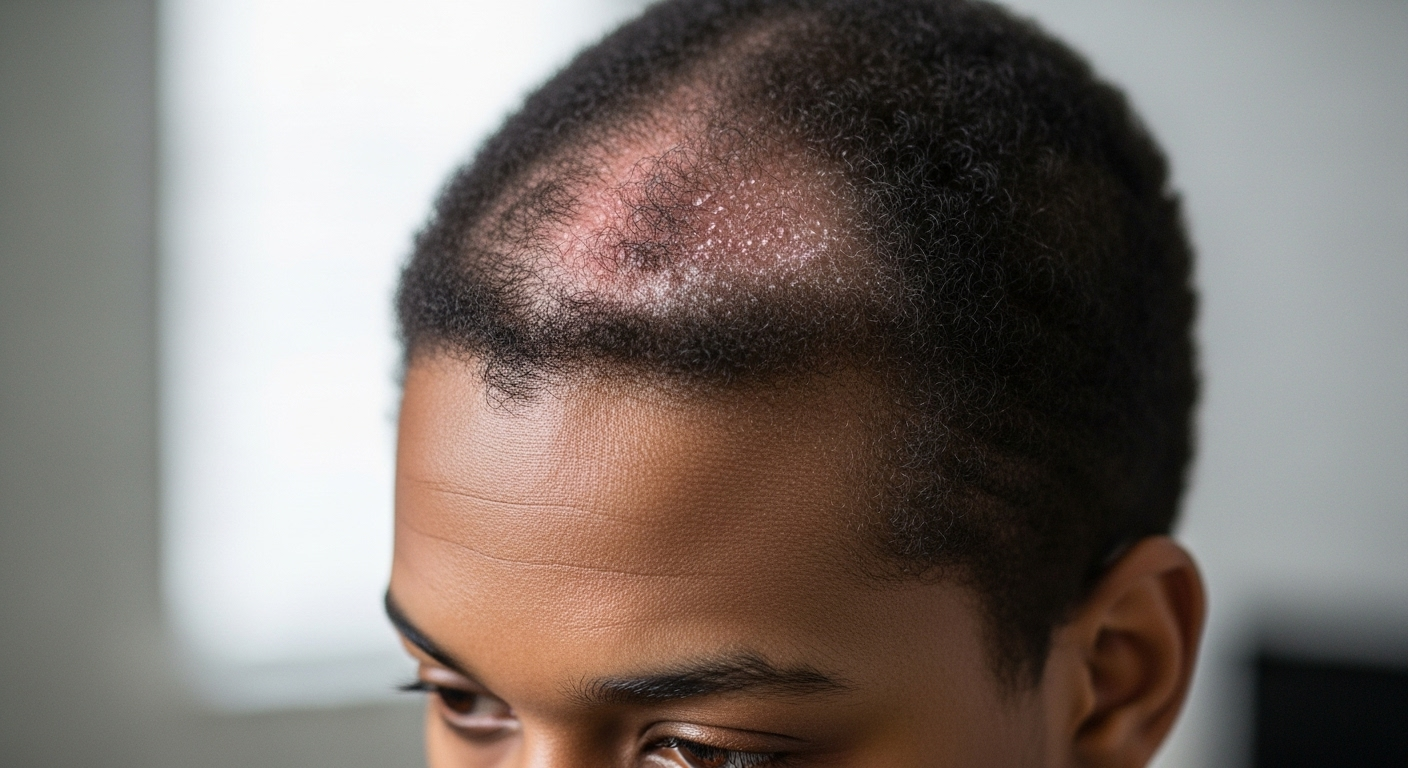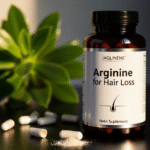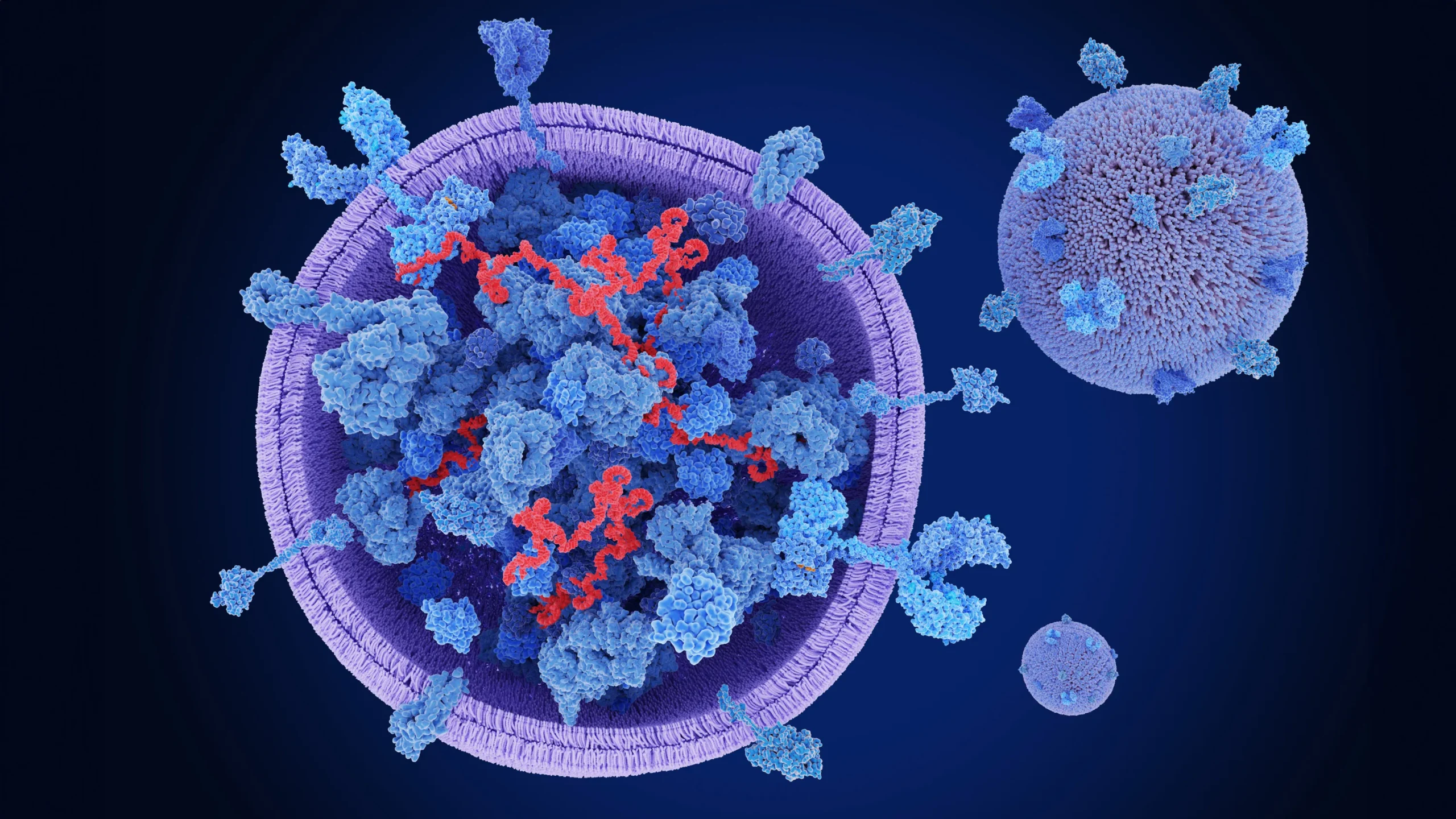Are you experiencing sudden hair thinning and suspect your environment might be the cause? Mold exposure hair loss is an often-overlooked condition where toxic mold and indoor pollutants trigger scalp inflammation, hormonal imbalances, and immune disruption—leading to significant hair shedding. This guide explains the connection between mold and hair loss, how to diagnose it, and …
Are you experiencing sudden hair thinning and suspect your environment might be the cause? Mold exposure hair loss is an often-overlooked condition where toxic mold and indoor pollutants trigger scalp inflammation, hormonal imbalances, and immune disruption—leading to significant hair shedding. This guide explains the connection between mold and hair loss, how to diagnose it, and what steps you can take to recover and regrow healthy hair. Learn from expert insights, proven therapies, and real-life recovery timelines.
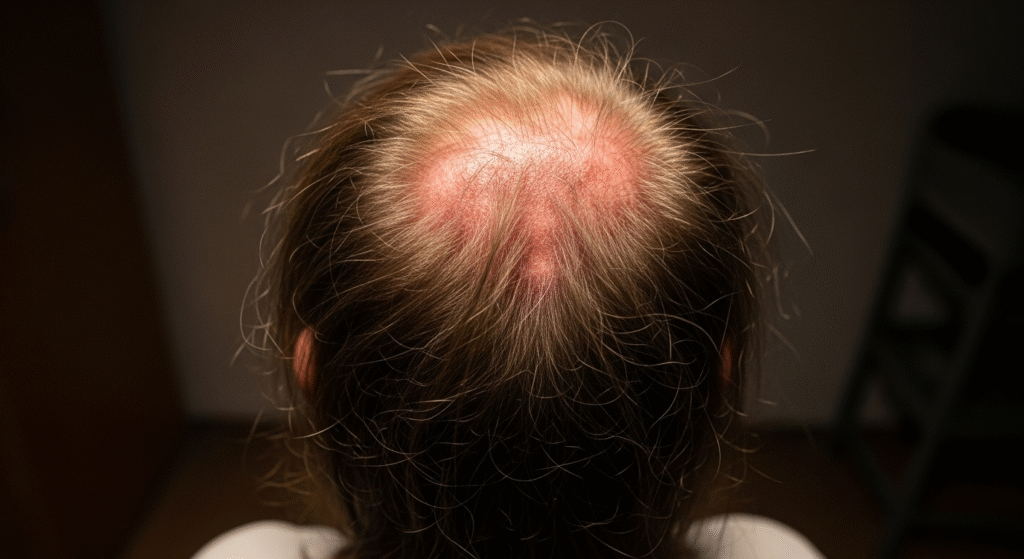
What Is Mold Exposure Hair Loss?
Mold exposure hair loss refers to hair shedding or thinning caused by prolonged contact with mold spores or their toxins (mycotoxins). These toxins disrupt the body’s immune, hormonal, and inflammatory pathways—damaging the scalp and weakening hair follicles.
Common types of indoor mold that may trigger such responses include Aspergillus, Stachybotrys (black mold), and Penicillium. The damage is usually gradual, making it difficult to pinpoint mold as the root cause without proper evaluation.
How Mold Affects the Body and Hair Growth
Chronic Inflammation and Scalp Circulation
Mold exposure activates histamines and cytokines in the body, creating low-grade systemic inflammation. This inflammation can constrict blood vessels in the scalp, reducing nutrient delivery and oxygenation—both essential for healthy follicle function.
Immune System Dysregulation and Autoimmunity
For some individuals, exposure to mold can result in immune system dysregulation or even trigger autoimmune responses like alopecia areata, where the immune system mistakenly attacks hair follicles.
Hormonal and Thyroid Imbalances
Mycotoxins may interfere with the adrenal and thyroid glands. Elevated cortisol levels (the stress hormone) and reduced thyroid function can lead to diffuse hair shedding known as telogen effluvium.
Nutrient Absorption Issues
Mold-induced inflammation can damage the gut lining, leading to malabsorption of nutrients vital for hair health—like biotin, zinc, iron, and vitamin D. This nutritional deficiency further contributes to weak or thinning hair.
Signs and Symptoms Of Mold Exposure Hair Loss
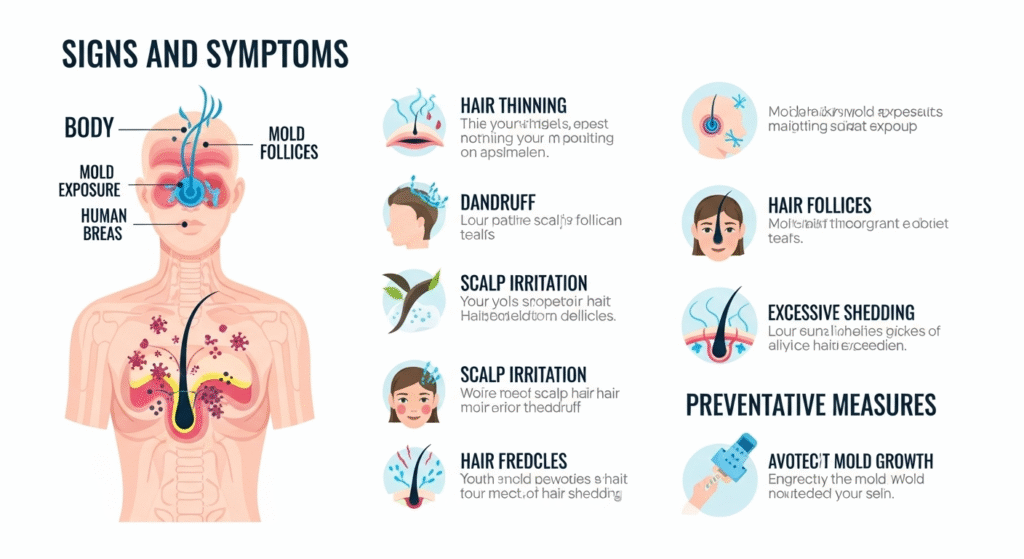
Recognizing mold-related hair loss involves observing both scalp-specific and systemic symptoms.
Scalp-related signs:
- Diffuse thinning or patchy bald spots
- Increased shedding during brushing or showering
- Itchy, flaky, or inflamed scalp
Systemic mold exposure signs:
- Fatigue and brain fog
- Chronic sinus or respiratory issues
- Skin rashes and sensitivity
- Sensitivity to smells or light
Diagnosing Mold-Related Hair Loss
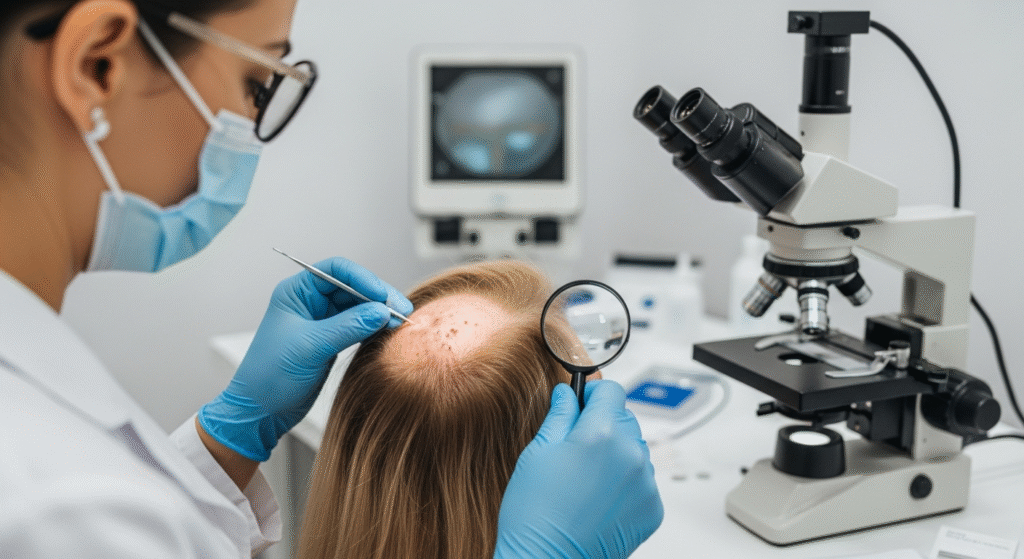
Environmental Assessment
Start by investigating your living or working space for mold presence. Signs may include:
- Musty odors
- Water damage, wall discoloration
- Poor ventilation or visible mold patches
Professional mold inspectors can use moisture meters and air quality testing to confirm the presence of harmful spores.
Medical Evaluation
Allergy Testing: Blood IgE tests or skin-prick testing may detect mold sensitivities.
Blood Tests: Look for elevated inflammatory markers, low iron or vitamin D, thyroid irregularities, and elevated cortisol.
Scalp Examination: Dermatologists may perform a scalp biopsy or trichoscopy to rule out other causes like fungal infections, androgenic alopecia, or seborrheic dermatitis.
Rule Out Other Causes
Ensure a full diagnostic workup to rule out:
- Genetic or androgenetic alopecia
- Post-COVID hair shedding
- Hormonal changes (e.g., PCOS, menopause)
- Nutritional deficiencies unrelated to mold
Treatment and Recovery Strategies of Mold Exposure Hair Loss
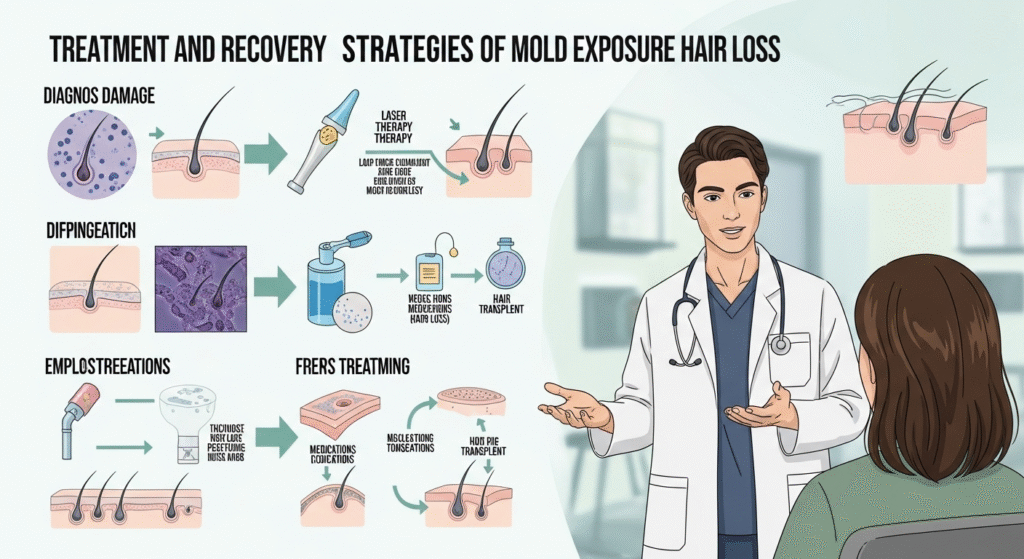
Remove the Mold Source
Environmental remediation is the first and most crucial step. Without eliminating mold exposure, other treatments may offer only temporary results.
- Hire licensed professionals for deep mold removal
- Fix plumbing leaks and improve ventilation
- Use HEPA filters and dehumidifiers to maintain <50% humidity indoors
Scalp and Skin Care
Use targeted topical treatments to reduce inflammation and support follicle health:
- Antifungal or anti-inflammatory shampoos containing ketoconazole or tea tree oil
- Topical corticosteroids for scalp inflammation (prescribed)
- pH-balancing and nourishing hair masks
Support Body Healing
Focus on reducing inflammation and improving nutrient absorption:
- Anti-inflammatory diet (high in leafy greens, berries, omega-3s)
- Gut healing supplements (probiotics, L-glutamine, zinc)
- Adaptogens (ashwagandha, reishi) to regulate stress response
Hair Regrowth Techniques
Once the source is removed and the body is healing, hair regrowth can begin with:
- Biotin, zinc, and vitamin D supplementation
- Low-Level Laser Therapy (LLLT) to stimulate hair follicles
- Minoxidil under guidance for targeted regrowth
Recovery Timeline and Expert Insights
Hair Recovery Timeline
| Recovery Phase | Timeframe |
|---|---|
| Mold removal & detox | Weeks 1–4 |
| Inflammation control | Weeks 2–6 |
| Scalp healing | Weeks 4–8 |
| Noticeable regrowth | Months 2–3 |
| Full restoration | Months 6–9 |
Note: Hair grows in cycles, so results may vary depending on individual health and the extent of mold exposure.
Patient Case Study
Sarah, 35, noticed extreme shedding after moving into a damp apartment. After confirming mold toxicity and treating with detox protocols, antifungal shampoos, and LLLT, she regained 80% of her hair density within 7 months.
Preventing Recurrence
Once resolved, take proactive steps to prevent mold-related relapse:
- Keep indoor humidity below 50%
- Vent bathrooms and kitchens
- Check behind walls, carpets, and under sinks for leaks
- Clean AC filters and ducts regularly
- Use air purifiers with activated carbon filters
FAQs
Can mold really cause hair loss?
Yes, mold releases mycotoxins that disrupt immune and hormonal function, both of which are vital for healthy hair growth.
How long until hair grows back after mold removal?
Initial regrowth may begin around 8–12 weeks post-removal, with full recovery in 6–9 months depending on individual factors.
Should I take hair supplements?
Yes, under guidance. Focus on biotin, zinc, vitamin D, and collagen—especially if nutrient absorption was compromised by mold.
What tests confirm mold-related hair loss?
Environmental mold testing, IgE panels, and scalp biopsies can support a diagnosis when combined with symptoms.
Is LLLT effective post-mold exposure?
Low-Level Laser Therapy (LLLT) improves blood circulation and follicle stimulation, making it a beneficial non-invasive option.
Ready to take your next step:
If you suspect your environment is contributing to hair loss, don’t delay. Book a consultation with Dr. Uzma Irfan an ISHRS Certified in Islamabad to assess your living space, conduct medical evaluations, and create a personalized hair recovery plan. Regaining your hair starts with reclaiming a healthy environment.

